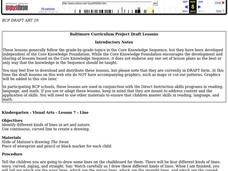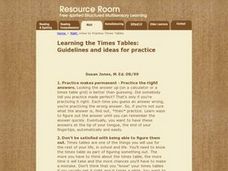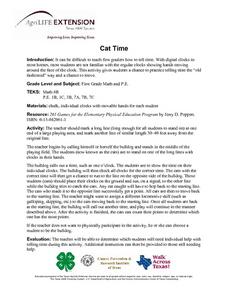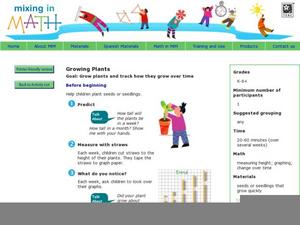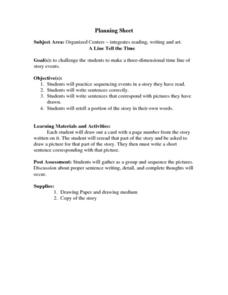Curated OER
Finish Line Fluency
Students practice repeated readings to improve their fluency. They read sentences to practice fluency and expression. They work in pairs using racetrack and racecar graphics to motivate their fluency improvement. They time one...
Curated OER
Tallies Tell It All
Students explore data collection through the use of tally marks. After a demonstration of the use of tally marks students complete various inquires where they create a chart documenting the number of times a desired result happens. They...
Curated OER
Eight Lines about home
Students brainstorm positive things about their city and write an eight line poem about it.
Curated OER
Online Clock Exercises
In this online clock and time worksheet, students solve and grade on line several exercises including drawing the hands on four clocks with a specific time, matching equal time quantities and filling in the blanks in four time word...
Curated OER
Martian Sun Times
Learners become weather reporters for the Martian Sun Times newspaper to gather. interpret, and compare current weather information for Mas and Earth. Final articles be posted on-line. There are seven investigations in this unit.
Curated OER
Adaptive Worksheet-Telling Time
In this adaptive telling time worksheet, students read times shown on a set of clock faces. Page has no additional activities.
Curated OER
What Time Is It?
For this ESL telling time worksheet, students analyze 7 pictures that show clocks and times to the nearest 5 minutes. On the line provided, students write the time in words.
Houghton Mifflin Harcourt
Unit 3 Math Vocabulary Cards (Grade 1)
Reinforce math vocabulary with a set of flashcards. Each card showcases a boldly typed word or a picture representation with labels. The topics are geometry related and include terms such as cones, faces, pyramids, sides, and...
Science Matters
Earthquakes and Volcanoes Pre-Assessment
See how much your class knows about earthquakes and volcanic activity and how these events shape geologic features. The first lesson in the series of 20 is a pre-test to find out what pupils already know. It includes 10 vocabulary...
Curated OER
Visual Arts
Students identify different kinds of lines in art and nature. They use continuous, curved line to create a drawing.
Curated OER
Learning the Times Tables: Guidelines And Ideas for Practice
Young scholars observe and demonstrate a variety of techniques for learning their times tables. They check their answers on a calculator, create flashcards and a number line, develop a number chart from 1-100, write times table story...
Curated OER
Cat Time
First graders demonstrate telling time on clocks. They stand at one end of a field while the teacher calls out a time. They )cats) who set their clocks to the correct time try to run past the teacher (bulldog) without getting caught.
Curated OER
Lines Of Connection
We need the help of your history detectives! After giving them a set of questions to answer, reading groups must create their own timeline of the events. Then, as a class, have each group present their timelines. What is different? Why...
Mixing In Math
Mixing in Math: Growing Plants
Whether you have your class plant seeds or begin when sprouts are visible, math skills are used here to predict and track growth over time. Straw bar graphs show plant height on a given day while the graph as a whole shows changes over...
Little Book Lane
"Th" Words
That is a great word because it starts with the th sound. There are so many words that start with the consonant digraph th. Early readers are going to love this packet of fun worksheets, games, flashcards, and images that were created...
Curated OER
Bar Graphs With Intervals
Give your math class a comprehensive understanding of bar graphs with this series of lessons. The resource is divided into three parts, and all of the accompanying worksheets are included. The class will study different bar graphs,...
Curated OER
Collective Poetry: Teaching Tolerance
Help your class create collective poetry following a simple, engaging model from Teaching Tolerance (tolerance.org). Each young poet writes five things on an index card: sayings from others, favorite sound, favorite place, favorite...
Student Handouts
Letter from Christopher Columbus to Luis de Sant Angel Announcing His Discovery (1493)
When Christopher Columbus landed, he found many things to comment on. Have your class read this letter that he wrote to Luis de Sant Angel in 1493. The text is split up into sections. Each section is paired with two to three...
Curated OER
Organized Centers
Young scholars are challenged to make three-dimensional time lines of story events from stories they have read. They practice sequencing events and writing sentences correctly. In addition, they write sentences that correspond with...
Curated OER
Henry's Freedom Box
Third graders create a shipping box from a cardboard material. In this measuring lesson, 3rd graders read the book Henry's Freedom Box and discuss the main idea. In the story a slave ships himself to freedom and the students measure and...
Curated OER
Center Time
First graders recognize and represent mathematical relationships using symbols and use number sentences with operational symbols to solve problems. They complete various activities such as tug of war, monkeys on a vine, and hit and miss....
Curated OER
Functions and Graphing
Graphing functions in a real world application makes math come to life. Learners graph points on a coordinate plane and identify various points on a graph by working through a set of real world problems. This is a perfect review exercise.
Utah Education Network (UEN)
Linear Graphs Using Proportions and Rates
Using a TI-73 or other similar graphing calculator middle school math majors investigate the linear relationship of equivalent proportions. After a brief introduction by the teacher, class members participate in a timed pair share...
Mathematics Vision Project
Geometric Figures
Logical thinking is at the forefront of this jam-packed lesson, with young mathematicians not only investigating geometric concepts but also how they "know what they know". Through each activity and worksheet, learners wrestle with...











